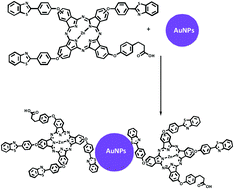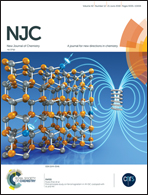A gold–chitosan composite with low symmetry zinc phthalocyanine for enhanced singlet oxygen generation and improved photodynamic therapy activity†
Abstract
Novel zinc(II) 3-(4-((3,17,23-tris(4-(benzo[d]thiazol-2-yl)phenoxy)phthalocyanine-9-yl)oxy)phenyl)propanoic acid (complex 3) was synthesised. Complex 3 was subsequently reacted with gold nanoparticles (AuNPs), chitosan (CT) and a gold–chitosan (AuCT) hybrid to form 3-AuNPs, 3-CT and 3-AuCT, respectively. The conjugates afforded a decrease in fluorescence quantum yield with a corresponding increase in the triplet and singlet quantum yields compared to complex 3. The in vitro dark cytotoxicity and photodynamic therapy activity (PDT) of complex 3 and 3-AuCT composites were investigated against epithelial breast cancer cells (MCF-7) with both the samples showing minimum dark cytotoxicity. They both accounted for a cell viability of ≥90% at a concentration of ≤59.2 μg mL−1. 3-AuCT showed better PDT activity (compared to 3 alone) with less than 50% viable cells at a concentration of ≥29.6 μg mL−1 making it potentially applicable for PDT. On the other hand, AuCT displayed some activity against cancer cells, probably due to photothermal activity since gold is a light absorber, however it had more than 50% viable cells at a concentration of ≤59.2 μg mL−1.



 Please wait while we load your content...
Please wait while we load your content...